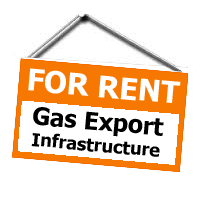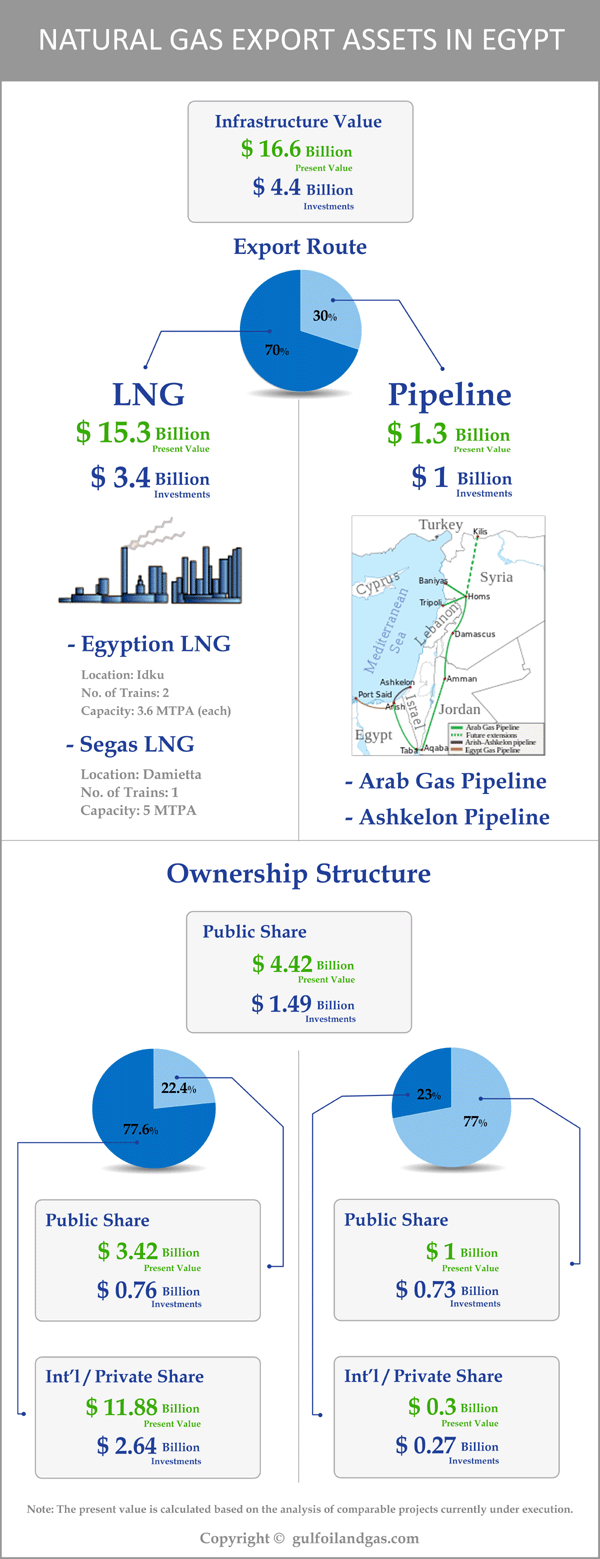Egypt Gas Puzzle: The $16 billion Abandoned Gas Export InfrastructureSource: Gulfoilandgas.com - Articles 3/13/2014, Location: Egypt |
|
|
|
|
 Unlike other commodities, exporting natural gas is a very expensive decision. Because of the high risk involved, gas producing countries need to make sure they have long lasting enough surplus before investing in gas export infrastructure.
Most of the Egyptian Natural Gas exports were halted following the Egyptian People revolution in January 2011 and the collapse of the Mubarak government. With the population bubble and industrial needs, today Egypt consumes an amount of gas close to what had been forecasted for 2025. Because of the increasing local demand, Egypt decided to divert for domestic use the share of gas foreign firms normally get to export. The gas export strategy was based on wrong information and unrealistic assumptions about future demand. Today, the public debate in Egypt is not about the gas export price, it is about the justification for spending billions of taxpayer dollars on the unused gas export infrastructure and its negative impact on the local economy. The following Infographic describes the Natural Gas Export Infrastructure in Egypt.  Natural Gas Export Infrastructure A number of large projects have been developed in Egypt during the last decade for the export of Egyptian Natural gas. Gas export infrastructure in Egypt comprise cross country pipelines and Liquefied Natural Gas (LNG) facilities. Egypt Natural Gas export assets include: Pipelines: Arab Gas Pipeline: The Arab Gas Pipeline is a natural gas pipeline constructed to export Egyptian natural gas to Jordan, Syria and Lebanon, with a separate line to Israel. It has a total length of 1,200 kilometers and a pipeline diameter of 36 Inch. The Arab Gas Pipeline consists of three phases: The first phase runs from El-Arish (Egypt) to Aqaba (Jordan) and is split into land and marine sections with a total length of 264 km, 36” diameter and a capacity of 10.3 billion cubic meter per year. The second phase starts from Aqaba port to El Rehab in Jordan just 24 km from the Syrian borders with a length of 394 km. The third phase of the Arab Gas Pipeline has a total length of 319 km from Jordan to Syria. A 90 km stretch runs from the Jordan–Syria border to the Deir Ali power station. From there the pipeline runs through Damascus to the Al Rayan gas compressor station near Homs. The pipeline is fully owned by the Egyptian public sector. Arish-Ashkelon Pipeline: The Arish-Ashkelon pipeline is a 100 kilometers submarine gas pipeline connecting the Arab Gas Pipeline with Israel. Although it is not officially a part of the Arab Gas Pipeline project, it branches off from the same pipeline in Egypt. In 2010, the pipeline was supplying approximately half of the natural gas consumed in Israel, with the other half being supplied from domestic resources. East Mediterranean Gas Company (EMG) is the owner and operator of the pipeline. EMG include shareholders from public and private investors from Egypt and Israel. The total project investment was 300,000,000 USD. The Egyptian General Petroleum Company has a minority stake of 10% in this project. LNG Facilities: Segas LNG: Segas LNG facility is located at Damietta on the Mediterranean Coast 60 kilometers west of Port Said, it has a liquefaction capacity of approximately 5 million tonne per annum (MTPA) of liquefied natural gas (LNG) by air cooled refrigeration and fractionation. The total investment in the project is 1.3 Billion USD. The Egyptian public sector ownership in the project is 20%. Egyptian LNG: The Egyptian LNG facilities, located at Idku, comprise two LNG production trains and include the common facilities such as storage tanks, loading jetty and utilities. Train 1 was designed to produce 3.6 MTPA of LNG, where its production has been sold to Gaz de France under 20-year sales and purchase agreement. The total investment in train 1 is 1.12 Billion USD. The entire 3.6 MTPA output of the second train has been sold to BG Gas Marketing, a subsidiary of BG Group, under a 20 year sales and purchase agreement. The total investment in train 2 is approximately 1 Billion USD. The Egyptian public sector ownership in both trains is 24%. Egypt is now forced to explore different options, to solve the gas puzzle without introducing further complications or negative impact on the environment. We shall try to analyze the situation over a number of articles during the next period to better understand the natural gas puzzle in Egypt. Articles in the Egypt Gas Puzzle series:
|
|
 |
|||||
|
Oil Egypt E-Marketplace - Subscription Packages - Benefits |
||
|